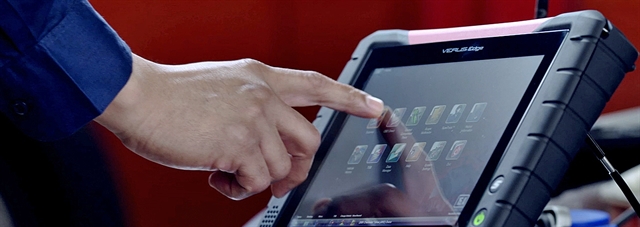This Technical Focus article explores the evolution of vehicle diagnostics and ponders how long it will be before every technician needs a diagnostic platform.
The evolution of vehicle diagnostics tells us that what started out as a subject important to only a few technicians has now become an every-day necessity within the workshop.
Ensuring that you understand diagnostics and stay on top of developments is important to your business in wider terms but also for many of those smaller jobs that come through your doors.
One modern innovation that helped diagnostics become such an every-day task is the tyre pressure monitoring system (TPMS), which has been fitted to all new cars since 2014.
If a vehicle comes into a workshop with an illuminated TPMS warning light, this can be diagnosed and fixed by following a series of steps.
First of all, use a Snap-on car diagnostic scan tool such as the VERUS Edge to establish which fault codes are present and which wheel has the problem then, with the aid of a Sun service lift, remove the wheel from the vehicle.
The next stage will be to remove the tyre from the wheel using the Sun STC5545 tyre changer and, if necessary, replace the wheel’s TPMS sensor.
Re-mount the tyre with the STC5545 and it is then important to make sure that the wheel is still correctly balanced before it is re-attached to the vehicle.
Carry out the check using a Sun SWB300L wheel balancer, which pinpoints the precise position to locate the wheel weight positioning, eliminating the requirement to re-balance the wheel, then complete the repair by attaching it back to the vehicle.
The final stage will be to validate the repair by re-connecting the VERUS Edge, confirming that no further faults are present and clearing any codes that remain.
 |
|
Vehicle diagnostics has become an every-day part of the modern workshop - even in the most unexpected of areas.
|
TPMS is just one example of how diagnostics has become more prevalent in the workshop but there are many other tasks you face regularly today that need you to reach for your platform.
The introduction of Xenon lighting, for instance, changed the game when it came to replacing bulbs on vehicles equipped in such a way.
Should the light module on a vehicle with Xenon lighting fail then you will usually need to replace the complete control module and then re-program it to the vehicle using a Snap-on diagnostic platform.
Scan tools help on all types of repair
But even some of the more long-standing vehicle parts such as wing mirrors and wiper blades now need the aid of diagnostic tools in order for repairs to be completed.
New wing mirrors need to be programmed to a vehicle while on many new models you can’t even begin to replace wiper blades without the help of a diagnostic tool.
When the ignition on vehicles such as the Peugeot 407 is switched off the blades automatically return to a position below a panel which sits just above the bonnet.
This means you can’t access them without the aid of a diagnostic platform, which connects to the vehicle and takes control to allow you to raise the blades ready for replacement.
So what does all of this mean for life in the workshop?
It definitely shows us how far vehicle technology has advanced and it also demonstrates how important diagnostics is to today’s businesses as it needs to be incorporated in so many jobs, rather than just replacing a part and handing the vehicle back to your customer.
And it does open up another question – how long will it be before a diagnostic platform is as important a weapon in a technician’s armoury as sockets and spanners?
Date posted: 18 October 2017